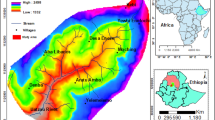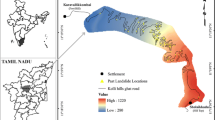This paper reports the use of a GIS based Probabilistic Certainty Factor method to assess the geo-environmental factors that contribute to landslide susceptibility in Tevankarai Ar sub-watershed, Kodaikkanal. Landslide occurrences are a common phenomenon in the Tevankarai Ar sub-watershed, Kodaikkanal owing to rugged terrain at high altitude, high frequency of intense rainfall and rapidly expanding urban growth. The spatial database of the factors influencing landslides are compiled primarily from topographical maps, aerial photographs and satellite images. They are relief, slope, aspect, curvature, weathering, soil, land use, proximity to road and proximity to drainage. Certainty Factor Approach is used to study the interaction between the factors and the landslide, highlighting the importance of each factor in causing landslide. The results show that slope, aspect, soil and proximity to roads play important role in landslide susceptibility. The landslide susceptibility map is classified into five susceptible classes – low, very low, uncertain, high and very high − 93.32% of the study area falls under the stable category and 6.34% falls under the highly and very highly unstable category. The relative landslide density index (R index) is used to validate the landslide susceptibility map. R index increases with the increase in the susceptibility class. This shows that the factors selected for the study and susceptibility mapping using certainty factor are appropriate for the study area. Highly unstable zones show intense anthropogenic activities like high density settlement areas, and busy roads connecting the hill town and the plains.






Similar content being viewed by others
References
Akinci H, Dogan S, Kiligoclu C and Temiz M S 2011 Production of landslide susceptibility map of Samsun (Turkey) city centre by using Frequency Ratio Model; Int. J. Phys. Sci. 6(5) 1015–1025.
Ayalew L and Yamagishi H 2005 The application of GIS-based logistic regression for landslide susceptibility mapping in the Kakuda–Yahiko Mountains, Central Japan; Geomorphology 65(1/2) 15–31.
Baeza C and Corominas J 2001 Assessment of shallow landslide susceptibility by means of multivariate statistical techniques; Earth Surf. Proc. Land. 26 1251–1263.
Bai S, Lü G, Wang J, Zhou P and Ding L 2010 GIS-based rare events logistic regression for landslide-susceptibility mapping of Lianyungang, China; Environ. Earth Sci. doi: 10.1007/s12665-010-0509-3.
Binaghi E, Luzi L and Madella P 1998 Slope instability zonation: A comparison between certainty factor and fuzzy Dempster–Shafer approaches; Nat. Hazards 17 77–97.
Can T, Nefeslioglu H A, Gokceoglu C, Sonmez H and Duman T Y 2005 Susceptibility assessments of shallow earth flows triggered by heavy rainfall at three catchments by logistic regression analyses; Geomorphology 72 250–271.
Chauhan S, Mukta Sharma, Arora M K and Gupta N K 2010 Landslide susceptibility zonation through ratings derived from Artificial Neural Network; Int. J. Appl. Earth Observ. Geoinf. 12 340–350.
Chung C F and Fabbri A G 1993 The representation of geosciences information for data integration; Non-renewable Resour. 2(2) 122–139.
Constantin Mihaela, Martin Bednarik, Marta C Jurchescu and Marius Vlaicu 2011 Landslide susceptibility assessment using the bivariate statistical analysis and the index of entropy in the Sibiciu Basin (Romania); Environ. Earth Sci. 63(2) 397–406.
Dai F C and Lee C F 2002 Landslide characteristics and slope instability modeling using GIS, Lantau Island, Hong Kong; Geomorphology 42 213–228.
Das I, Sahoo S, van Westen C, Stein A and Hack R 2010 Landside susceptibility assessment using logistic regression and its comparison with a rock mass classification system, along a road section in northern Himalayas (India); Geomorphology 114 627–637.
Duman T Y, Can T, Gokceoglu C, Nefeslioglu H A and Sonmez H 2006 Application of logistic regression for landslide susceptibility zoning of Cekmece Area, Istanbul, Turkey; Environ. Geol. 51 241–256.
Ercanoglu M 2005 Landslide susceptibility assessment of SE Bartin (West Black Sea region, Turkey) by artificial neural networks; Nat. Hazards Earth Syst. Sci. 5 979–992.
Ercanoglu M and Temiz F A 2011 Application of logistic regression and fuzzy operators to landslide susceptibility assessment in Azdavay (Kastamonu, Turkey); Environ. Earth Sci. 64 949–964.
Erener A and Düzgün H S B 2010 Improvement of statistical landslide susceptibility mapping by using spatial and global regression methods in the case of More and Romsdal (Norway); Landslides 7(1) 55–68.
Evangelin R S and Rajamanickam V 2011 Landslide susceptibility mapping of Tevankarai Ar sub-Watershed, Kodaikkanal Taluk, India, using weighted similar choice fuzzy model; Nat. Hazards 59 401–425.
Evangelin R S, Kumaravel, P, Rajamanickam V and Sarnathan E 2011a Landslide susceptibility analysis using probabilistic frequency ratio model – a geospatial based study; Arabian J. Geosci., doi: 10.1007/s12517-011-0356-x.
Evangelin R S, Kumaravel P, and Rajamanickam V 2011b GIS based landslide susceptibility mapping of Tevankarai Ar Sub-watershed, Kodaikkanal, India using binary logistic regression analysis; J. Mountain Sci. 8 505–517.
Fenghau Su, Peng Cui, Jianqiang Zhang and Lingzhi Xiang 2010 Susceptibility assessment of landslides caused by the Wenchuan earthquake using a logistic regression model; J. Mountain Sci. 7(3) 234–245.
Fernandez Merodo J A, Pastor M, Mira P, Tonni L, Herreros M I, Gonzalez E, Tamagnini R 2004 Modelling of diffuse failure mechanisms of catastrophic landslides; Comput. Methods Appl. Mech. Engrg. 193 2911–2939.
Ghimire M 2011 Landslide occurrence and its relation with terrain factors in the Siwalik Hills, Nepal: Case study of susceptibility assessment in three basins; Nat. Hazards 56 299–320.
Glade T and Crozier M J 2005 The nature of landslide hazard impact; In: Landslide Hazard and Risk (eds) Glade T, Anderson M G and Crozier M (Chichester: John Wiley), pp. 43–74.
Gokeceoglu C and Aksoy H 1996 Landslide susceptibility mapping of the slopes in the residual soils of the Mengen region (Turkey) by deterministic stability analysis and image processing techniques; Eng. Geol. 44(1–4) 147–61.
Hamid R P, Pradhan B, Gokceoglu C, Majid Mohammadi and Hamid R Moradi 2012 Application of weights-of-evidence and certainty factor models and their comparison in landslide susceptibility mapping at Haraz watershed, Iran; Arabian J. Geosci., doi: 10.1007/s12517-012-0532-7.
Heckerman D 1986 Probabilistic interpretation of MYCIN’s certainty factors. In: Uncertainty in Artificial Intelligence (eds) Kanal L N and Lemmer J F (Dordrecht: Kluwer Academic Publishers), pp. 167–196.
Kanungo D P, Sarkar S, Shaifaly Sharma 2011 Combining neural network with fuzzy, certainty factor and likelihood ratio concepts for spatial prediction of landslides; Nat. Hazards 59(3) 1491–1512.
Kayastha P, Dhital M R and De Smedt F 2012 Landslide susceptibility mapping using weight of evidence in the Tinau watershed, Nepal; Nat. Hazards, doi: 10.1007/s11069-012-0163-z.
Keefer D K and Larsen M C 2007 Assessing landslide hazards; Sciences 316 1136–1137.
Lan H X, Zhou C H, Wang L J, Zhang H Y and Li R H 2004 Landslide hazard spatial analysis and prediction using GIS in the Xiaojiang watershed, Yunnan, China; Eng. Geol. 76 109–128.
Lee S and Pradhan B 2006 Probabilistic landslide hazard and risk mapping on Penang Island, Malaysia; J. Earth Syst. Sci. 115(6) 661–672.
Lee S and Pradhan B 2007 Landslide hazard mapping at Selangor, Malaysia using frequency ratio and logistic regression models; Landslides 4 33–41.
Lee S and Sambath T 2006 Landslide susceptibility mapping in the Damrei Romel area, Cambodia using frequency ratio and logistic regression models; Environ. Geol. 50(6) 847–855.
Lim Khai Wern, Tay Lea Tien and Lateh H 2011 Landslide hazard mapping of Penang Island using probabilistic methods and logistic regression; IEEE International Conference on Imaging Systems and Techniques, doi: 10.1109/IST.2011.5962174, pp. 273–278.
Luzi L and Pergalani F 1999 Slope instability in static and dynamic conditions for urban planning: The ‘Oltre Po Pavese’ Case History (Regione Lombardia – Italy); Nat. Hazards 20 57–82.
Magliulo P, Antonio Di Lisio, Filippo Russo and Antonio Zelano 2008 Geomorphology and landslide susceptibility assessment using GIS and bivariate statistics: A case study in southern Italy; Nat. Hazards 47 411–435.
Mancini F, Ceppi C and Ritrovato G 2010 GIS and statistical analysis for landslide susceptibility mapping in Daunia area, Italy; Nat. Hazards Earth Syst. Sci. 10 1851–1864.
Mezughi T H, Akhir J M, Rafek A and Abdullah I 2011 Landslide assessment using frequency ratio model applied to an area along the E-W highway (Gerik-Jeli); Am. J. Environ. Sci. 7(1) 43–50.
Nagarajan R, Roy A, Vinod Kumar, Mukherjee A and Khire M V 2000 Landslide hazard susceptibility mapping based on terrain and climatic factors for tropical monsoon regions; Bull. Eng. Geol. Environ. 58 275–287.
Nandi A and Shakoor A 2010 A GIS-based landslide susceptibility evaluation using bivariate and multivariate statistical analyses; Eng. Geol. 110 11–20.
Nefeslioglu H A, Candan Gokceoglu, Harun Sonmez and Tolga Gorum 2011 Medium-scale hazard mapping for shallow landslide initiation: The Buyukkoy catchment area (Cayeli, Rize, Turkey); Landslides 8(4) 459–483.
Nefeslioglu H A, Gokceoglu C and Sonmez H 2008 An assessment on the use of logistic regression and artificial neural networks with different sampling strategies for the preparation of landslide susceptibility maps; Eng. Geol. 97 171–191.
Pradhan B 2010 Landslide susceptibility mapping of a catchment area using frequency ratio, fuzzy logic and multivariate logistic regression approaches; J. Indian Soc. Rem. Sens. 38 301–320.
Regmi N R, Giardino J R and Vitek J D 2010 Assessing susceptibility to landslides using models to understand observed changes in slopes; Geomorphology 122 25–38.
Remondo J, González A, Díaz de Terán J R, Fabbri A and Cheng Ch F 2003 Validation of landslide susceptibility maps; examples and applications from a case study in Northern Spain; Nat. Hazards 30(3) 437–449.
Santacana N, Baeza Baeza, Jordi Corominas, Ana De Paz and Jordi Marturiá 2003 A GIS-based multivariate statistical analysis for shallow landslide susceptibility mapping in La Pobla de Lillet Area (Eastern Pyrenees, Spain); Nat. Hazards 30 281–295.
Shortliffe E H and Buchanan G G 1975 A model of inexact reasoning in medicine; Mathematical Biosci. 23 351–379.
van Westen C J, van Asch T W J and Soeters R 2006 Landslide hazard and risk zonation — why is it still so difficult?; Bull. Eng. Geol. Environ. 65 167–184.
Vijith H and Madhu G 2008 Estimating potential landslide sites of an upland sub-watershed in Western Ghat’s of Kerala (India) through frequency ratio and GIS; Environ. Geol. 55(7) 1397–1405.
Xu C, Xu X, Dai F and Arun K Saraf 2012 Comparison of different models for susceptibility mapping of earthquake triggered landslides related with 2008 Wenchuan earthquake in China; Comput. Geosci., doi: 10.1016/j.cageo.2012.01.002.
Yilmaz I 2010 Comparison of landslide susceptibility mapping methodologies for Koyulhisar, Turkey: Conditional probability, logistic regression, artificial neural networks, and support vector machine; Environ. Earth Sci., doi: 10.1007/s12665-009-0394-9.
Zhu Lei and Huang Jing-Feng 2006 GIS-based logistic regression method for landslide susceptibility mapping on regional scale; Journal of Zhejiang University Science A 7(12) 2001–2017.
Author information
Authors and Affiliations
Corresponding author
Rights and permissions
About this article
Cite this article
Sujatha, E.R., Rajamanickam, G.V. & Kumaravel, P. Landslide susceptibility analysis using Probabilistic Certainty Factor Approach: A case study on Tevankarai stream watershed, India. J Earth Syst Sci 121, 1337–1350 (2012). https://doi.org/10.1007/s12040-012-0230-6
Received:
Revised:
Accepted:
Published:
Issue Date:
DOI: https://doi.org/10.1007/s12040-012-0230-6




